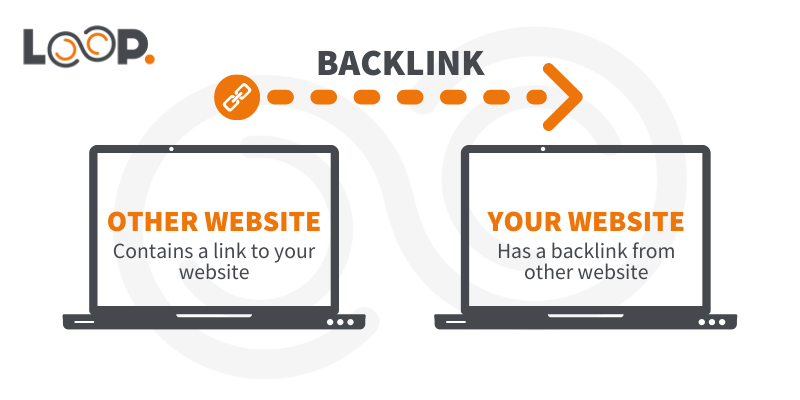Mel is our Partner Strategy & Delivery Manager and also a CIM Chartered Marketer, a testament to her commitment to excellence in the field. But Mel’s contributions don’t stop at the office door. Beyond her professional endeavours, she leads an active life as a qualified run leader and dedicated volunteer. Her experience in these roles has streamlined her leadership and teamwork skills, making her an invaluable asset when it comes to collaborating on projects and ensuring their success. Her sharp insights, strategic thinking, and knowledge have made her a backbone in our team’s ability to drive results for clients in this industry. Mel will make sure that we can approach marketing challenges from all angles and deliver outstanding results for our clients.
Posted on 11/04/2022 by Melanie Comerford
What are Backlinks in SEO?
The world of SEO can be a tricky place to navigate. If you’re new to SEO you’ll find yourself inundated with various key terms or buzzwords that may mean very little to you. Fear not, we are here to help! SEO and all of the various elements that go into it are a must-have for building a strong presence online. Search engine optimisation techniques are crucial for establishing trust and enhancing your authority, without them, your website could be lost amongst billions of other search results.
Essentially the goal of SEO is to expand your business’s visibility online by ranking higher for organic results in search engine results pages, SERPs for short. The higher your website sits in organic search results increases your traffic, and in turn, increases your opportunity to achieve conversions.
SEO requirements have changed over the years and will only continue to do so for years to come. According to a number of different sources, Google uses over two hundred different signals to determine your website’s position in search results. One of these key ranking signals is backlinks, they essentially act as a thumbs up from one website to the other. Some may call it a modern-day popularity contest. This is, of course, a condensed description; below we’ve outlined everything you need to know about backlinks and how to build your link building strategy.
What are Backlinks?
Backlinks often referred to as inbound or incoming links, are links from one website to a webpage on another website. As we’ve mentioned in the previous section, major search engines like Google, consider these backlinks as a thumbs up or ‘vote’ for a specific page. Search engines view your backlinks as indicators of high-quality and trustworthy content.
How do Backlinks work?
Backlinks or inbound links play a huge role in search engine algorithms, SEO and your overall ability to grow your visibility online. The formula for building your website’s authority with backlinks is pretty straightforward but there are a handful of complexities to keep in mind. Historically, the more backlinks a website had the higher it would rank in search engines, but the likes of Google have evolved their algorithms to look further beyond this. With Google using over 200 different signals to appropriately rank your content, the number of backlinks your website has is just part of this equation.
Initially, backlinks were the foundation of Google’s earliest algorithm, however, this traditional process of sorting search engine results unknowingly gave users the ability to manipulate search results. By leveraging various bad SEO practices users could secure huge numbers of backlinks that paid little to no relevance to the on-page content. Nowadays, however, Google will be very quick to identify these bad or unnatural processes and throw out penalties to all that are caught, you have been warned!
Back in the present day, the effectiveness of backlinks is widely debated. As an expert within the industry, we recognise that backlinks remain a key ranking signal in the world of SEO, but are more of a component in a much bigger equation.
Why Are Backlinks Important?
Rather than discuss why you need backlinks, let’s think about how your overall SEO strategy could be impacted without them. Without backlinks, the effectiveness of your other search optimisation tactics will be drastically reduced. This challenge will only be exaggerated if you’re trying to rank for a particularly competitive keyword.
In a short summary, backlinks help search engines like Google identify trustworthy and credible websites. The goal of a search engine is to provide users with the most relevant and accurate information in line with their search query. Whilst we could argue that still to this day they might not always get it right, they’ve certainly evolved over the years.

The Different Types of Backlinks
In SEO not every backlink will be of value to you, and in fact, some backlinks could actually do more harm than good for your website. Not all backlinks are created equally, a single link from a reputable website can be more powerful than hundreds of low-quality backlinks. As well as users, Google will look at the websites referring to your website so they need to be relevant to the content in question.
High-Value vs Low-Value Backlinks
For example, you’ve written a blog about a groundbreaking new medicine and a well-established pharmaceutical brand creates a link to your content. In addition to this, a number of gambling websites from overseas also link to your content, which links will be more valuable in this scenario? The pharmaceutical brand, for two reasons; the first is that it comes from a reputable and high-authoritative site and two; because both yours and their websites are relevant to one another.
Linked to our example above, the pharmaceutical website is likely to have high authority, also referred to as ‘Domain Authority’. The more authority has, the more authority it can pass to your website via the link. These links are notoriously hard to obtain but it is possible given the right high-quality content, we’ll explore this further in the ‘How-to build backlinks’ section.
DoFollow Backlinks
Backlinks are commonly bucketed into two different types, NoFollow or Follow links. Each possesses its own value, to get the most out of your SEO strategy and the tactics you deploy, you’ll need to get to grips with both.
Essentially DoFollow links are backlinks that pass authority from one website to the other. Sometimes referred to as ‘Link Juice’ or ‘Link Points’, these are essentially the nicknames for a website’s ‘amount’ of authority. DoFollow or Follow links enable this link juice to be passed from one website to the linked-to site, supporting it to boost its page rank and climb higher in SERPs as a result.
NoFollow Backlinks
Juxtaposed by this, we have NoFollow links. These links do not enable the link points to be shared from one website to the other, thus they offer little to no support in boosting your page ranking ability. A NoFollow tag essentially tells search engines ‘not to count this’. At this point, you’re probably wondering to yourself why such a thing exists, and the reason links back to our points about bad-practice SEO.
When backlinks were first introduced as a ranking signal, suddenly forums, chats and content comments were inundated with spammy comments linking to the individual’s content. This resulted in genuine and valuable pieces of content being lost amongst poorly executed content, creating a poor user experience. It didn’t take long for Google to catch wind of what was happening and quickly introduced a solution, the NoFollow attribute.
Primarily leveraged by reference-rich websites such as Wikipedia or various Forum platforms now automatically apply the NoFollow tag to published links in order to deter spammy behaviour.
NoFollow links can still provide value. In some circumstances, your NoFollow tag can be removed, enabling your website to reap the benefits of a link from an authoritative website. This is a rare occasion but for particularly unique or valuable content, it can happen so bear that in mind.
How to Build Backlinks?
Now for the part you’ve all been waiting for, how to build your backlinks. In the world of SEO, there is an ongoing debate about whether link-building tactics still hold a large influence on the success of your website online. However, when paired with engaging content it’s a good practice that you can implement yourself.
So, let’s start by uncovering what link building is. In short, it’s the process of obtaining hyperlinks from other websites that send users to your site. Search engines like Google use these links to crawl the web, learning all the while how websites and webpages link together. Link building techniques can vary, some are ethical, some are not, we are obviously going to advise you to use the best practices. Mastering the art of link-building has the potential to enhance your SEO and boost your organic rankings.
Guest Posting
Sometimes referred to as Guest Blogging, it is essentially creating a piece of content for another company’s website. It’s more common for guest bloggers to write content for those within their industry, where their expertise will lie. Guest blogging offers benefits for all parties involved, the content producer, the website and of course the users.
By sharing content on other trusted websites, you’ll establish yourself and your brand as a knowledge source that provides value, offering your expertise to what could be an entirely new pool of prospects. We’ve all been guilty of consistently posting content for content’s sake, guest blogging offers the opportunity to create something different not to mention the promotional benefits that could follow.
It’s worth having a good think about what you would like to get out of this before diving in headfirst. Consider your marketing and overarching business objectives too. The likelihood is you want to take up guest blogging primarily as an SEO tactic but a great bi-product of this is the creation of relationships with those you decide to work with.
Obtaining Editorial Links
Editorial links are obtained naturally, without being paid and asked for. Commonly used to direct users to the source of data like a statistic or a resource like an infographic. Editorial links indicate to users where the source of that information came from. The weight that these links carry is disputed by many, but we consider this to be a very good practice as it’s beneficial to the website being linked to and builds on the user experience so that they can trust what they are reading is legitimate.
These links are more difficult to obtain given their natural occurrence and because of this editorial links and citations are great examples of earned links. Google is continually devaluing other methods of link building so securing a strong group of earned links is something to aspire to have.
Create Linkable Assets
Linkable, high-value assets like infographics tie in with the previous editorial links. Using these graphics within your content can increase website traffic, improve domain authority and enhance your SEO. With 67% of B2B businesses now creating and publishing infographics, there is no denying that this medium is valuable. Many websites use infographics to break down studies and data as well as explain complex processes quickly.
To obtain a link to your infographic you’ll need to create a well-structured, well-researched and engaging piece of visual content. Like editorial links, you need to produce something that is worth a website linking out to or including in their own content.
You could also consider adding embed code to make it easier for other websites to share your graphic. You may also look into adding a CTA for website owners/managers to share the visual on their own site, whilst this offers no guarantee that they will, the CTA is there should they want to.
Broken Link Building
Broken link building should be a key tactic within your overall link building strategy, but it can be time-consuming. In short, broken link building is when you identify broken/dead links and recreate the content to fulfil that link. Once you’ve produced the content you then reach out to those using the broken link and suggest linking to your content instead, taking its place.
You might be wondering what the purpose is, the bottom line is that nobody wants a website with dead or broken links because it equates to a bad user experience. To reduce time, we’d recommend using an online tool to help you identify broken links across other websites. When investigating sites for dead links, refrain from picking random sites, consider your audience and your niche to find the best placements, you’ll save an abundance of time this way too.
It’s likely that if you find a broken link, other domains will also be linking to that expired webpage, you could reach out to all of these websites and suggest substituting the broken link with a link to your content. Beware though, the uptake of your offer will likely be slim with many in the SEO industry have discussed low response rates to outreach.
SEO at Loop Digital
That concludes our introductory guide to the world of SEO backlinks and link-building techniques. At Loop Digital, our team specialise in creating bespoke SEO strategies whatever your industry is. Our team has years of experience developing SEO programmes for startups, SMEs, and large corporations. Unlock your company’s potential with our exceptional SEO solutions. Call us on 01604 806020 or speak to one of our experts today.
Looking for your next opportunity?
Digital marketing careers
We’re always on the lookout for talented individuals to join our ever growing team. If you think you’d be a great match for Loop Digital, we’d love to hear from you.

Stay in the loop... subscribe to our newsletter for all the latest industry news
"*" indicates required fields






